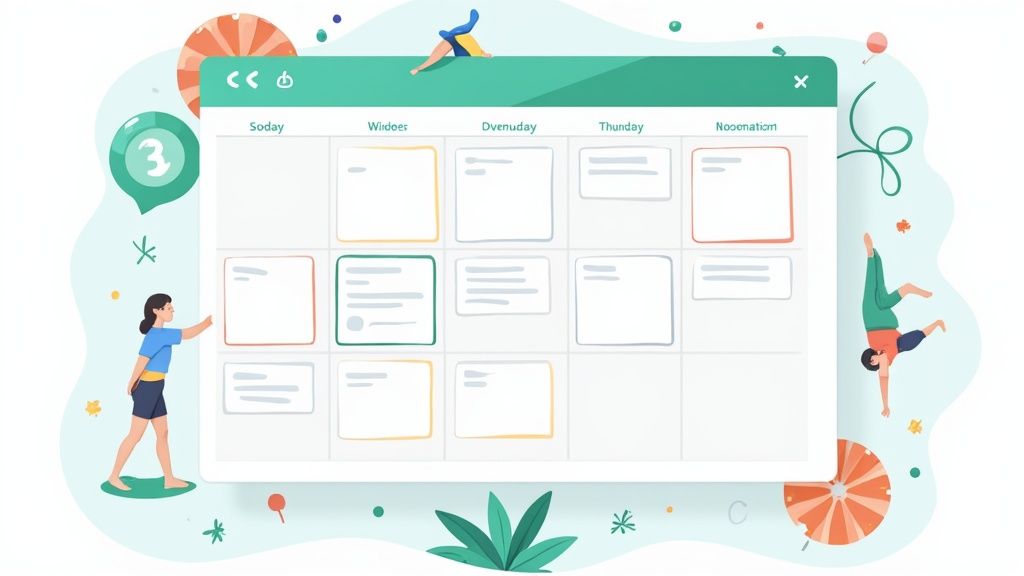How to Reduce Workplace Stress: Expert-Backed Strategies That Actually Work
Understanding the True Cost of Workplace Stress

The financial toll of workplace stress extends far beyond individual employees to impact entire organizations. In the United States, companies spend an estimated $300 billion annually dealing with the effects of workplace stress through increased healthcare costs, higher rates of absenteeism, and frequent employee turnover. These numbers paint a clear picture - addressing workplace stress isn't just about supporting employee wellbeing, it's essential for business success.
The Hidden Impacts of Stress on Business Performance
When employees face constant pressure, their ability to think creatively and solve problems effectively diminishes. The mental burden of stress leaves little room for innovation or adapting to market changes. For instance, healthcare settings have documented direct links between high stress levels and increased medication errors. This shows how stress can compromise work quality and lead to costly mistakes. The impact ripples through organizations, affecting both employee performance and business outcomes.
How Stress Affects Team Dynamics and Company Culture
The effects of chronic workplace stress often spread beyond individuals to damage team relationships and organizational culture. In high-pressure environments, negativity and conflict tend to increase while collaboration suffers. For example, when one team member experiences ongoing stress, their changed behavior and attitude can influence the entire group's mood and effectiveness. As stress spreads, productivity drops and turnover rises, creating significant costs for companies trying to maintain stability and performance.
Moving Beyond Traditional Approaches to Stress Management
Simply offering gym memberships or occasional wellness workshops isn't enough to address workplace stress at its roots. Organizations need comprehensive strategies that work at individual, team and company-wide levels to create real change. This includes flexible work arrangements, accessible mental health support, and proactive stress prevention programs. Taking action to reduce workplace pressure leads to more engaged employees, stronger culture, and better business results. The research is clear - managing stress effectively is crucial for both employee wellbeing and organizational success.
Creating a Flexible Work Environment That Works

The modern workplace needs more than occasional work-from-home days - it requires a complete rethinking of how, when, and where work gets done. When employees have more control over their schedules and environment, they experience less stress and pressure. This sense of autonomy helps people feel more in charge of their work lives.
Flexible Scheduling: Empowering Employees to Manage Their Time
Giving employees control over their work hours does more than just let them pick start and end times. Some may choose compressed workweeks, fitting their hours into fewer days. Others might adjust their schedule daily based on personal needs - like a parent working around school drop-offs or an early bird capitalizing on morning productivity. For instance, letting people align work hours with their natural rhythms and life commitments helps them stay focused and reduces overwhelm. This flexibility in managing time leads to better work-life balance and lower stress levels.
Remote Work Options: Beyond the Traditional Office
While remote work has become common, making it truly effective requires thoughtful planning. Organizations need robust systems for virtual collaboration, clear availability guidelines, and a culture built on trust. Just as important is preventing isolation among remote team members. Regular video check-ins and virtual social activities help distributed teams stay connected and engaged. The goal is creating an environment where remote workers feel supported and part of the team, even when physically apart.
Measuring the Success of Flexible Arrangements: Data-Driven Insights
For flexible work to succeed long-term, companies must track key metrics and make adjustments based on results. This means monitoring employee satisfaction, productivity levels, and stress-related absences to understand what's working. If a team's output drops after switching to compressed weeks, for example, that signals the need to explore other flexible options. Getting employee input during assessments helps ensure solutions actually address their needs. The most effective flexible arrangements evolve based on real feedback and measurable outcomes. Successful programs find ways to meet both employee and organizational needs through ongoing evaluation and refinement.
Building Effective Stress Prevention Programs

While flexible work options are helpful, preventing workplace stress requires a more systematic approach. Organizations need to move beyond just managing stress after it occurs and focus on proactive prevention strategies that support employee wellbeing from the start.
Identifying the Early Warning Signs of Burnout
Just as doctors look for symptoms before an illness becomes severe, managers must learn to spot the subtle indicators of employee burnout early on. Common warning signs include unexpected drops in productivity, more frequent absences, and noticeable changes in someone's typical behavior and attitude. When employees start withdrawing from team activities, expressing cynicism, or having trouble focusing, these behaviors often signal growing stress levels. Being able to recognize these early red flags allows organizations to step in with support before burnout takes hold.
Proactive Interventions: Addressing Stress Before It Takes Hold
After identifying potential burnout risks, organizations can take specific steps to prevent stress from escalating. Effective interventions range from providing individual support through mental health resources and stress management training to implementing team-wide initiatives. Regular check-ins between managers and employees create space to discuss workload concerns and address stressors early. Open communication channels and reasonable workload expectations help employees feel comfortable raising issues before they become overwhelming.
Creating Sustainable Support Systems: Building a Culture of Resilience
Preventing workplace stress requires ongoing commitment and a supportive company culture - it's not a one-time fix. Organizations need to foster an environment where people feel part of a community and can comfortably ask for help when needed. This means offering concrete resources like employee assistance programs and mental health support, while also tackling underlying issues such as unrealistic deadlines or poor communication patterns. By addressing both individual needs and organizational factors, companies can create a work environment where employees feel valued and equipped to handle challenges. When implemented effectively, these prevention programs reduce both the human and financial costs of workplace stress while supporting long-term employee wellbeing.
Incorporating Mindfulness Into Daily Work Life

While stress prevention programs and flexible schedules help create better work environments, employees also need practical tools to handle daily pressures. Mindfulness offers a proven approach to reduce stress and improve wellbeing by helping people stay present and build mental resilience. Research shows that regular mindfulness practice can decrease perceived stress levels and emotional exhaustion, making it easier to handle workplace challenges.
Practical Mindfulness Techniques for the Workplace
Getting started with mindfulness doesn't require major changes - small, consistent practices make a real difference. For example, beginning meetings with 60 seconds of mindful breathing helps teams focus and feel more centered. Taking short mindful breaks throughout the day gives employees a chance to reset and recharge when feeling overwhelmed.
Mindful Breathing: Take several deep breaths and focus on the physical sensation of breathing in and out. This simple practice calms your nervous system in just a few minutes.
Body Scan Meditations: Check in with your body by mentally scanning from head to toe, noticing any areas of tension without trying to change them. This builds awareness of physical stress signals.
Mindful Walking: During breaks, walk slowly and pay attention to each step and your surroundings. This provides a refreshing mental pause while adding gentle movement.
Integrating Mindfulness Into Meetings and Team Interactions
Mindfulness can also strengthen how teams work together. When people practice active listening in meetings by focusing fully on the speaker without interrupting, it creates a more respectful and productive environment. Teams can then tackle challenges more effectively since people feel heard. Taking a mindful approach to communication by pausing before responding helps prevent misunderstandings and keeps discussions on track.
Overcoming Resistance to Mindfulness in the Workplace
Some employees may be skeptical about mindfulness at first. The key is presenting it as a practical tool for improving focus and managing stress, rather than as a spiritual practice. Share concrete examples of how other companies have successfully used mindfulness programs and point to research showing the benefits for productivity and wellbeing. Start with optional intro workshops and let people explore mindfulness at their own pace. Consider recommending the Moova app, which offers short activity breaks and exercises to support both physical and mental health. Remember that addressing workplace stress requires multiple approaches - mindfulness is one effective tool among many that can help create a healthier work environment.
Developing a Stress-Resistant Culture
Creating a work environment where employees thrive requires more than just mindfulness programs and stress management workshops. True stress reduction comes from building a culture where people feel empowered to handle challenges effectively. This approach focuses on making stress management an integral part of daily operations through proven strategies and supportive practices.
Fostering Open Communication and Psychological Safety
Open communication is essential for managing workplace stress. When team members can freely voice concerns without fear of negative consequences, they develop a sense of psychological safety that helps prevent stress from building up. For example, if someone is struggling with their workload, they should feel comfortable discussing it with their manager to find solutions together. This open dialogue helps distribute work more evenly and catch potential issues early. Just as pressure needs a release valve, teams need healthy ways to address challenges before they become overwhelming.
Setting Healthy Boundaries and Expectations
Clear boundaries and realistic expectations form another crucial element of stress management. This includes defining roles explicitly, establishing reasonable deadlines, and respecting work-life balance by discouraging after-hours work. When people understand what's expected and have manageable workloads, they feel more in control and experience less stress. Think of boundaries like the banks of a river - they help channel energy productively while preventing overflow. Well-defined limits not only reduce stress but also boost focus and output by creating sustainable working conditions.
Building Supportive Relationships Across Teams
Strong relationships between colleagues create a natural buffer against workplace stress. When team members feel connected and supported, they handle difficult situations better because they know they're not alone. Companies can nurture these bonds through team activities, mentoring programs, and both virtual and in-person social events. These connections create a sense of community where everyone supports each other. Much like a suspension bridge distributes weight across many cables, supportive relationships help share the load during challenging times.
Addressing Toxic Behaviors and Promoting Respect
A stress-resistant culture requires actively confronting harmful behaviors while promoting mutual respect. Organizations need clear policies against harassment and discrimination, along with training in conflict resolution. Problems left unaddressed will only grow worse and erode trust. By taking swift action against inappropriate conduct, companies show they value employee wellbeing. This creates an environment where people feel safe and supported, allowing them to focus on their work rather than workplace drama. Through consistent enforcement of respectful behavior, organizations build the foundation for a truly resilient culture.
Measuring and Maintaining Progress
Building a stress-free workplace requires ongoing attention and care, much like tending to a garden. Just as plants need regular monitoring and adjustments to thrive, your workplace stress reduction efforts need consistent evaluation to stay effective. This means tracking meaningful metrics while avoiding the creation of additional pressure on your team.
Identifying Key Performance Indicators (KPIs) for Stress Reduction
Before diving into data collection, it's essential to choose metrics that align with your stress reduction goals and provide real insight into your program's impact. Consider tracking these key indicators:
- Employee Turnover Rate: High turnover often signals underlying stress issues. Following this metric helps show if your initiatives are helping retain valuable team members.
- Absenteeism: Stress frequently leads to increased sick days. In the UK, 914,000 workers dealt with work-related stress, depression, or anxiety in 2021/22, significantly impacting attendance.
- Employee Satisfaction Surveys: Regular check-ins about stress levels and job satisfaction provide direct feedback. Research shows that 39% of employees with flexible work options report better mental health.
- Productivity Levels: While not directly measuring stress, declining output can indicate burnout. Track core performance metrics to see how stress reduction efforts affect work quality.
- Healthcare Costs: Since stress contributes to many health issues, monitoring stress-related medical claims offers broader perspective. U.S. businesses spend up to $300 billion yearly on workplace stress, with healthcare being a major component.
Gathering Meaningful Feedback: Going Beyond Basic Surveys
While surveys provide useful data points, getting the full picture requires a multi-channel approach:
- Focus Groups: Small group discussions allow employees to share more nuanced experiences and suggestions than standardized surveys can capture.
- One-on-One Conversations: Regular check-ins between managers and team members create safe spaces to discuss stress levels and identify issues early.
- Anonymous Feedback: Providing secure ways to share feedback anonymously encourages honest responses about sensitive topics like workplace stress.
Analyzing Trends and Making Data-Driven Improvements
After collecting feedback, look for patterns that reveal bigger issues. For example, if one department consistently reports high stress, that area likely needs focused attention. Use this information to fine-tune your approach - if employees aren't connecting with mindfulness sessions, explore other stress management options or provide more education about the benefits. Let real feedback guide program adjustments, just as successful businesses adapt their strategies based on customer responses.
Maintaining Momentum: Long-Term Strategies for Success
Make stress management a core part of your company's daily operations by including it in performance reviews and leadership training. Celebrate small wins to keep everyone engaged and motivated. Remember that reducing workplace stress isn't just good for employee wellbeing - it directly impacts your bottom line through improved productivity and reduced turnover.
Ready to take action on workplace stress? Try Moova, a mobile app that helps your team take effective activity breaks throughout the day. With personalized exercises and scheduled reminders, Moova makes it easy to combat prolonged sitting and boost physical and mental health.







